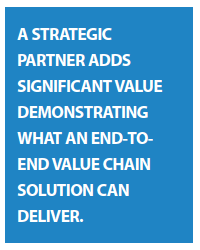 Q: What value can an end-to-end service value chain that touches all aspects of prescription medicine distribution and support bring to the market?
Q: What value can an end-to-end service value chain that touches all aspects of prescription medicine distribution and support bring to the market?
A: An end-to-end service value chain that is truly comprehensive in nature can bring significant value, especially to virtual and emerging pharmaceutical companies. Many of these companies have years of healthcare experience; however they lack the resources to create an end-to-end value chain and must therefore rely on a strategic partner or partners to create that network for them.
When virtual and emerging organizations are looking for a strategic partner for an end-to-end value chain solution, they need to offer close consideration of their own culture and goals (both long- and short-term) as well as of their prospective partners.
It’s important to align with a business partner that shares the same values, especially when this prospective relationship could continue for many years. Integrity, transparency, and a willingness to work collaboratively are key elements of a good working relationship. References from other clients can assist a pharmaceutical company in determining whether or not the prospective partner is a good fit. Virtual pharma companies (VPCs) should have a thorough vetting process with key criteria identified beforehand and a scorecard based on responses from the potential partner and their references.
So how can a pharmaceutical company vet a strategic partner and determine if they add value? Because companies that provide supply chain services have evolved, the services that they provide have also progressed to meet market needs. A true strategic supply chain partner has moved well beyond providing just pick, pack, and ship services and is able to support virtual and emerging pharmaceutical companies in a number of different areas. A single, strategic supply chain partner should now be capable of:
1. Implementing freight-forwarding services to assist VPCs with the movement of product from outside the United States;
2. Providing 3PL services including order to cash, chargeback, and rebate processing and returns processing;
3. Furnishing wholesale distribution services;
4. Creating and supporting direct-to-practitioner sampling, field sample support as well as white space programs;
5. Designing home delivery programs to support brand teams in overcoming formulary barriers and helping to drive patient access to medications;
6. Developing and deploying patient assistance programs to assist patients who are unable to afford the necessary medication;
7. Devising patient affordability solutions such as coupon, rebate, voucher, and co-pay card programs to reduce financial barriers to patients that have commercial insurance and helping to drive compliance and persistency; and
8. Creating brand support services that can assist patients in locating local pharmacies that stock medications and providing educational services to educate patients on their disease state.
 It is important to note that merely providing the services listed above does not make a service provider a strategic partner or necessarily demonstrate value. The key is not only the integration of the services, but also the integration of the IT architecture that supports each element. Without data standardization and integration, as well as reporting that provides insight and direction to decision makers, a pharmaceutical company may as well contract with separate service providers for each of the services listed above. By incorporating data from 3PL and distribution services, sample distribution, home delivery, patient assistance, and patient affordability solutions, a strategic partner can build a comprehensive and integrated view of a brand’s performance. A strategic partner adds significant value demonstrating what an end-to-end value chain solution can deliver. By consolidating these services and having an integrated IT/data architecture, a strategic partner can also offer significant cost savings.
It is important to note that merely providing the services listed above does not make a service provider a strategic partner or necessarily demonstrate value. The key is not only the integration of the services, but also the integration of the IT architecture that supports each element. Without data standardization and integration, as well as reporting that provides insight and direction to decision makers, a pharmaceutical company may as well contract with separate service providers for each of the services listed above. By incorporating data from 3PL and distribution services, sample distribution, home delivery, patient assistance, and patient affordability solutions, a strategic partner can build a comprehensive and integrated view of a brand’s performance. A strategic partner adds significant value demonstrating what an end-to-end value chain solution can deliver. By consolidating these services and having an integrated IT/data architecture, a strategic partner can also offer significant cost savings.
: How can 3PL organizations help virtual and emerging pharmaceutical companies reduce healthcare costs?
A: As the number of virtual pharmaceutical companies continues to grow, forwarding-thinking and flexible 3PL organizations can assist clients by partnering with them to identify potential issues, provide solutions, and reduce costs. A virtual pharma company requires expertise in a number of areas that an experienced 3PL partner can provide.
1. Pre-determined and pre-approved destruction schedules based upon the amount of expired, damaged, and quarantined product on hand can help ensure space is available for active and saleable inventory. While most companies are actively engaged with the destruction of pharmaceutical products, literature can be an overlooked item that can burden SKU management. Having a well-defined process for the identification and elimination of outdated literature can reduce storage costs.
2. The use of process improvement methodologies such as Lean and Six Sigma can address inefficient or outdated processes, thereby reducing client costs. Training the entire 3PL organization on the use of these tools is critical as is senior management support of the implementation. After training, employees should be quickly engaged in identifying areas for improvement, working as a part of a larger team on process mapping and the deployment of the mutually agreed upon changes. Having employees in functional areas take ownership of the change management process is important to ensure the change is maintained. Embracing a culture of process improvements is most successful when input is provided from employees in functional areas and is supported vertically within the organization. As the 3PL organization identifies efficiencies and improvements, employees can be moved to other areas that provide more of a value added service to the client.
3. Identifying the root cause(s) behind product damage is another way in which 3PL organizations can reduce costs. As many 3PL organizations are responsible for receiving and inventorying products on behalf of the client, they are in the best position to note damage to incoming products that may be systemic in nature. Issues at the manufacturing site, such as wrapping skids too tightly with insufficient corner protection (resulting in crushed corners) or improper pack-out on the skid, which can affect the stability of the product (resulting in crushing and spillage/damage) can be easily identified by the 3PL. Providing timely feedback to the client so they can address any issues at the manufacturing site can ensure that future damage is reduced or eliminated.
4. The use of dashboards and reporting, both standardized and customized, can greatly assist clients with improved forecasting and reduced lead times. By having an internal IT support team that understands important metrics to clients, a flexible 3PL can assist by building dashboards and reports that convert data into information that is actionable. Historical product shipment data can ensure the client is not ordering too much product and based upon historical demand, the product is being ordered with enough lead time to ensure timely delivery.
5. Returns processing is an area where a 3PL can deliver significant cost savings to a client. It is essential that clients have a well-defined returned goods policy and that the 3PL thoroughly understands which returned products are eligible for credit and which are not. Depending on the client’s annual volume of returns, a poorly defined returned goods policy or a 3PL with an unclear returned goods policy could cost a client hundreds of thousands of dollars a month. Detailed documentation on the processed returns, whether approved or denied, should be stored electronically and well indexed to quickly address any questions regarding why specific returned products were approved or denied for credit.
6. The 3PL organization should understand the proper slotting of high volume SKUs for picking efficiency. Additionally, the layout and flow of the pack-out process should be evaluated in relation to the positioning of high volume SKUs.
7. Transportation costs can be minimized in a number of ways. Having the client evaluate the need for expedited shipments and having well-defined criteria for which deliveries will need to be expedited will ensure the most efficient transportation method is utilized for parcel sized shipments. Overnight delivery when ground will suffice adds unnecessary expense to transportation costs. Consolidation of “full truck load and less than truck load" with key transportation partners can help to realize volume discounts and significant savings.
8. Quality assurance (QA) and compliance expertise within a 3PL organization can provide much-needed guidance to new and emerging pharmaceutical manufacturers. Given that virtual and emerging pharmaceutical companies tend to be resource constrained, a 3PL organization with an experienced and knowledgeable QA and compliance staff can provide essential guidance to clients and avoid costly regulatory missteps. Having the QA and compliance teams engaging the client as early as possible in the launch process can identify issues and provide necessary solutions to ensure that desired launch milestones are met.
With the vast knowledge an end-to-end strategic partner can offer an emerging pharmaceutical company, it would behoove new companies to evaluate potential partners with these criteria in mind. (PV)
With a relentless passion for quality patient care, Triplefin and Smith Medical Partners serve the frontlines of healthcare with lifesaving pharmaceuticals and industry experience in distribution and third-party logistics. Our focus on customer service creates true partnerships that help maximize patient care and reduce administrative burdens. With over a decade of leadership in the specialty pharmaceutical pipeline, we apply industry experience with market responsiveness. More than just product dispersal, we offer flexible services that facilitate cost-containment and efficiency.
For more information, visit triplefin.com and smpspecialty.com.


















